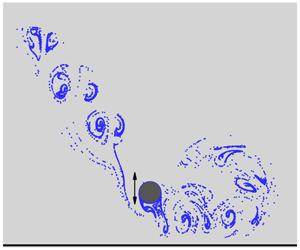当前位置:
X-MOL 学术
›
J. Fluid Mech.
›
论文详情
Our official English website, www.x-mol.net, welcomes your feedback! (Note: you will need to create a separate account there.)
Flow induced by an oscillating circular cylinder close to a plane boundary in quiescent fluid
Journal of Fluid Mechanics ( IF 3.7 ) Pub Date : 2020-06-15 , DOI: 10.1017/jfm.2020.355 Ming Zhao
Journal of Fluid Mechanics ( IF 3.7 ) Pub Date : 2020-06-15 , DOI: 10.1017/jfm.2020.355 Ming Zhao

|
Flow induced by an oscillating circular cylinder close to a plane boundary in quiescent fluid is simulated numerically by solving the two-dimensional Navier–Stokes equations. The aim of this study is to investigate the effects of the gap ratio between the cylinder and plane boundary ( $G$ ), the oscillation direction of the cylinder ( $\unicode[STIX]{x1D6FD}$ ) and the Keulegan–Carpenter ( $KC$ ) number on the flow at a low Reynolds number of 150. Simulations are conducted for $G=0.1$ , 0.5, 1, 1.5, 2 and 4, and $KC$ numbers between 2 and 12. Streaklines generated by releasing massless particles near the cylinder surface and contours of vorticity are used to observe the behaviour of the flow around the cylinder. The vortex shedding process from the cylinder is found to be very similar to that of a cylinder without a plane boundary except for $G=0.1$ and $\unicode[STIX]{x1D6FD}=0^{\circ }$ , where vortices cannot be generated below the cylinder. Two streakline streets exist for all the flow regimes if there was not a plane boundary. A streakline street from the cylinder can be affected by the plane boundary in three ways: (1) it is suppressed by the plane boundary and stops propagating; (2) it rolls up after it meets the boundary and forms a recirculation zone; and (3) it splits into two streakline streets and forms two recirculation zones after it attacks the plane boundary. A refined classification method for flow induced by an oscillating cylinder close to a plane boundary is proposed by including a variant number, which represents the behaviour of the streaklines, into the regime names, and all the identified flow regimes are mapped on the $KC$ – $G$ plane. The drag and inertia coefficients of the Morison equation are obtained using the least-squares method. A very small gap of $G=0.1$ significantly increases both the drag and inertia coefficients especially when $\unicode[STIX]{x1D6FD}=0^{\circ }$ . If $G=1$ and above, the plane boundary changes the drag coefficient by less than 10 % compared with that of a cylinder without a plane boundary, and the effect of the plane boundary on the inertia coefficient is weak only when the $KC$ number is sufficiently small and vortex shedding does not exist.
中文翻译:

静止流体中靠近平面边界的振荡圆柱体引起的流动
通过求解二维 Navier-Stokes 方程,对静止流体中靠近平面边界的振荡圆柱体引起的流动进行了数值模拟。本研究的目的是研究圆柱与平面边界之间的间隙比 ($G$)、圆柱的振荡方向 ($\unicode[STIX]{x1D6FD}$) 和 Keulegan-Carpenter ( $KC$ ) 在低雷诺数为 150 时的流动数。对 $G=0.1$、0.5、1、1.5、2 和 4 以及 $KC$ 数在 2 和 12 之间进行模拟。通过释放生成的条纹线圆柱表面附近的无质量粒子和涡流轮廓用于观察圆柱周围流动的行为。发现圆柱体的涡旋脱落过程与没有平面边界的圆柱体非常相似,除了 $G=0。1$ 和 $\unicode[STIX]{x1D6FD}=0^{\circ }$ ,其中圆柱下方不能产生涡流。如果没有平面边界,则所有流态都存在两条条纹街道。来自圆柱体的条纹街道可以通过三种方式受到平面边界的影响:(1)它被平面边界抑制并停止传播;(2)遇到边界后卷起,形成回流区;(3) 攻击平面边界后,分裂成两条条纹街道,形成两个再循环区。提出了一种对靠近平面边界的摆动圆柱体引起的流动进行精细分类的方法,将代表条纹行为的变量编号加入流态名称中,并将所有识别出的流态映射到 $KC$ – $G$ 飞机。Morison 方程的阻力和惯性系数是使用最小二乘法获得的。$G=0.1$ 的非常小的差距显着增加了阻力和惯性系数,尤其是当 $\unicode[STIX]{x1D6FD}=0^{\circ }$ 时。若$G=1$及以上,与无平面边界的圆柱相比,平面边界对阻力系数的改变小于10%,只有当$KC时平面边界对惯性系数的影响较弱$ 数足够小,不存在涡旋脱落。
更新日期:2020-06-15
中文翻译:

静止流体中靠近平面边界的振荡圆柱体引起的流动
通过求解二维 Navier-Stokes 方程,对静止流体中靠近平面边界的振荡圆柱体引起的流动进行了数值模拟。本研究的目的是研究圆柱与平面边界之间的间隙比 ($G$)、圆柱的振荡方向 ($\unicode[STIX]{x1D6FD}$) 和 Keulegan-Carpenter ( $KC$ ) 在低雷诺数为 150 时的流动数。对 $G=0.1$、0.5、1、1.5、2 和 4 以及 $KC$ 数在 2 和 12 之间进行模拟。通过释放生成的条纹线圆柱表面附近的无质量粒子和涡流轮廓用于观察圆柱周围流动的行为。发现圆柱体的涡旋脱落过程与没有平面边界的圆柱体非常相似,除了 $G=0。1$ 和 $\unicode[STIX]{x1D6FD}=0^{\circ }$ ,其中圆柱下方不能产生涡流。如果没有平面边界,则所有流态都存在两条条纹街道。来自圆柱体的条纹街道可以通过三种方式受到平面边界的影响:(1)它被平面边界抑制并停止传播;(2)遇到边界后卷起,形成回流区;(3) 攻击平面边界后,分裂成两条条纹街道,形成两个再循环区。提出了一种对靠近平面边界的摆动圆柱体引起的流动进行精细分类的方法,将代表条纹行为的变量编号加入流态名称中,并将所有识别出的流态映射到 $KC$ – $G$ 飞机。Morison 方程的阻力和惯性系数是使用最小二乘法获得的。$G=0.1$ 的非常小的差距显着增加了阻力和惯性系数,尤其是当 $\unicode[STIX]{x1D6FD}=0^{\circ }$ 时。若$G=1$及以上,与无平面边界的圆柱相比,平面边界对阻力系数的改变小于10%,只有当$KC时平面边界对惯性系数的影响较弱$ 数足够小,不存在涡旋脱落。



























 京公网安备 11010802027423号
京公网安备 11010802027423号